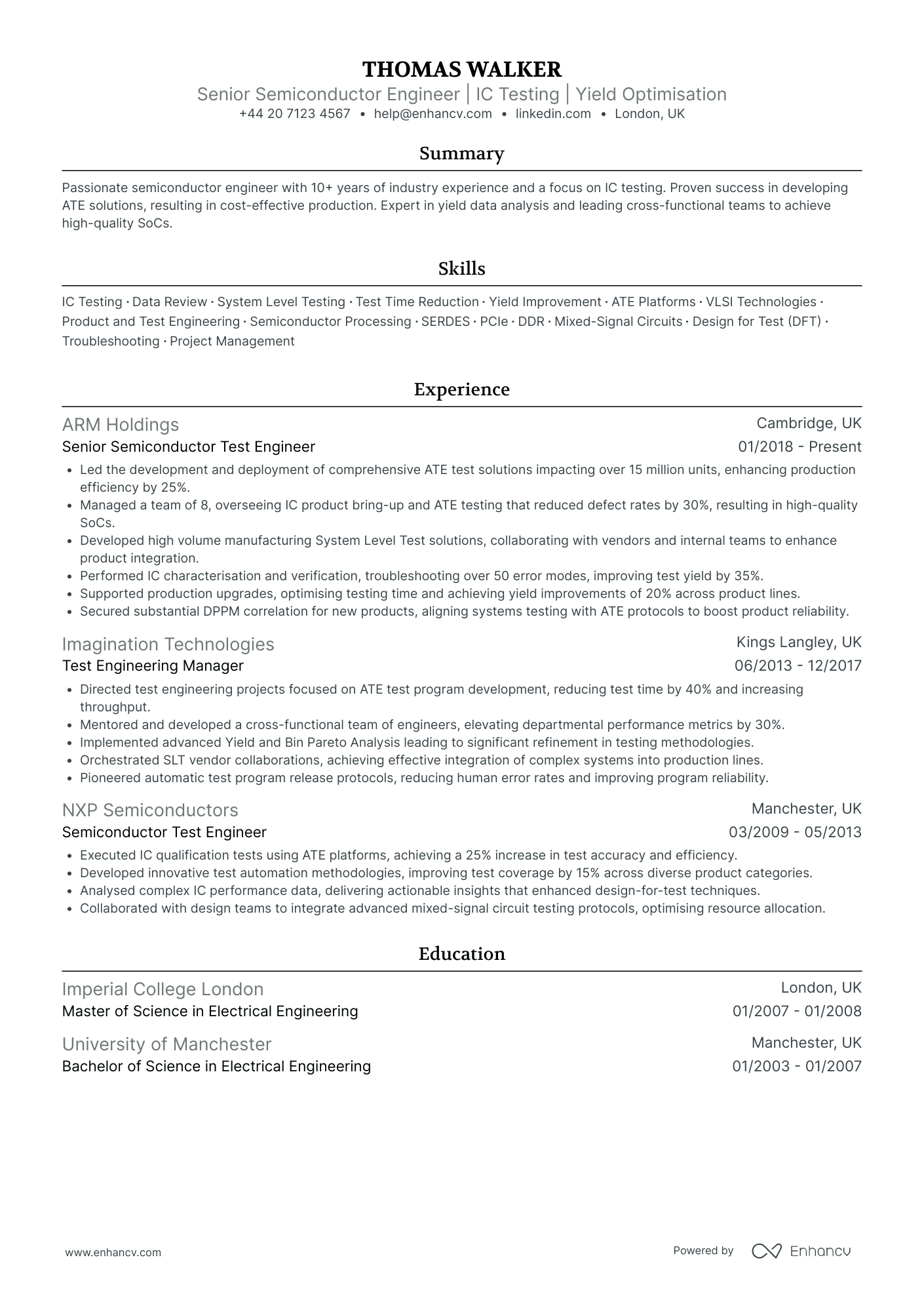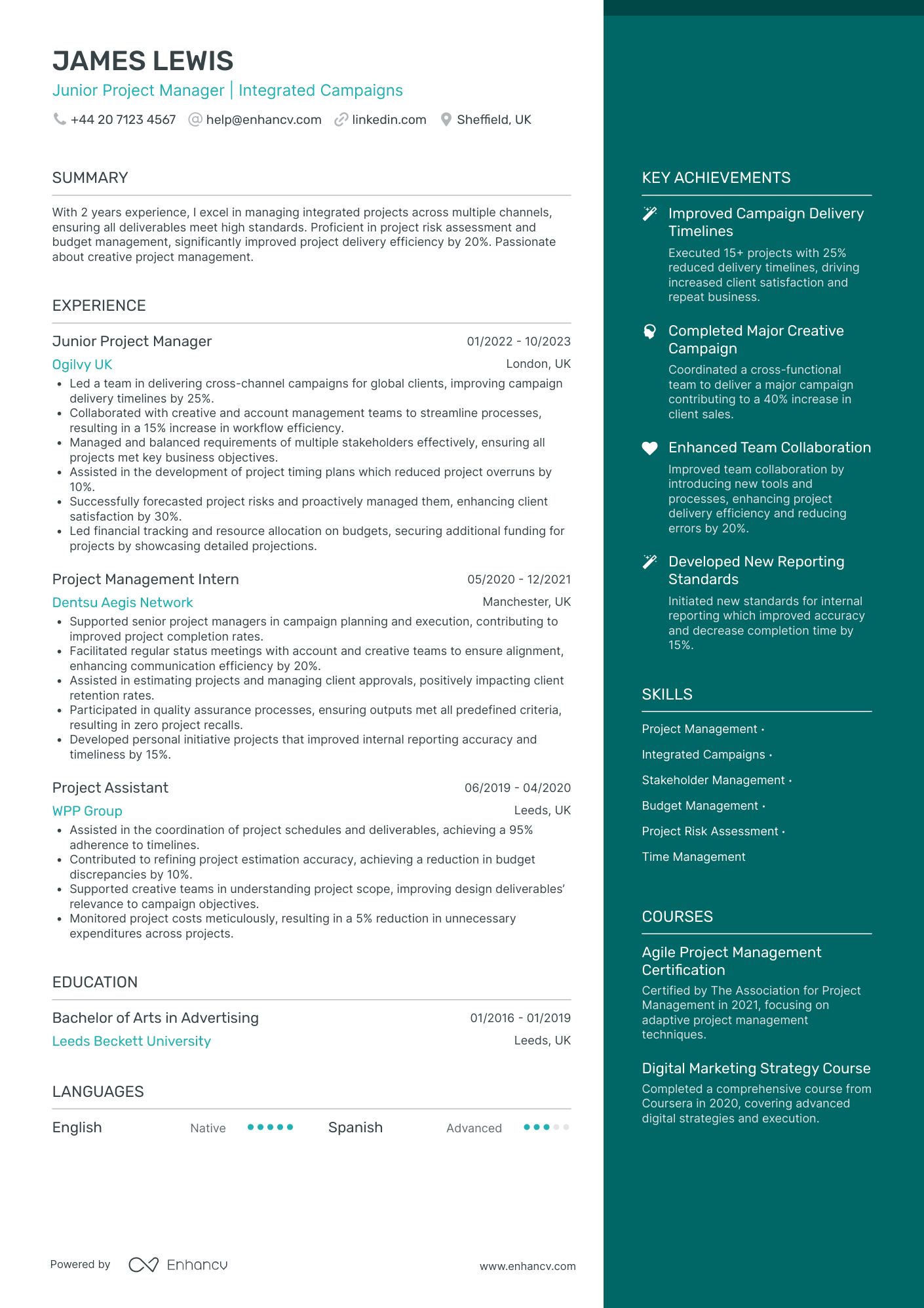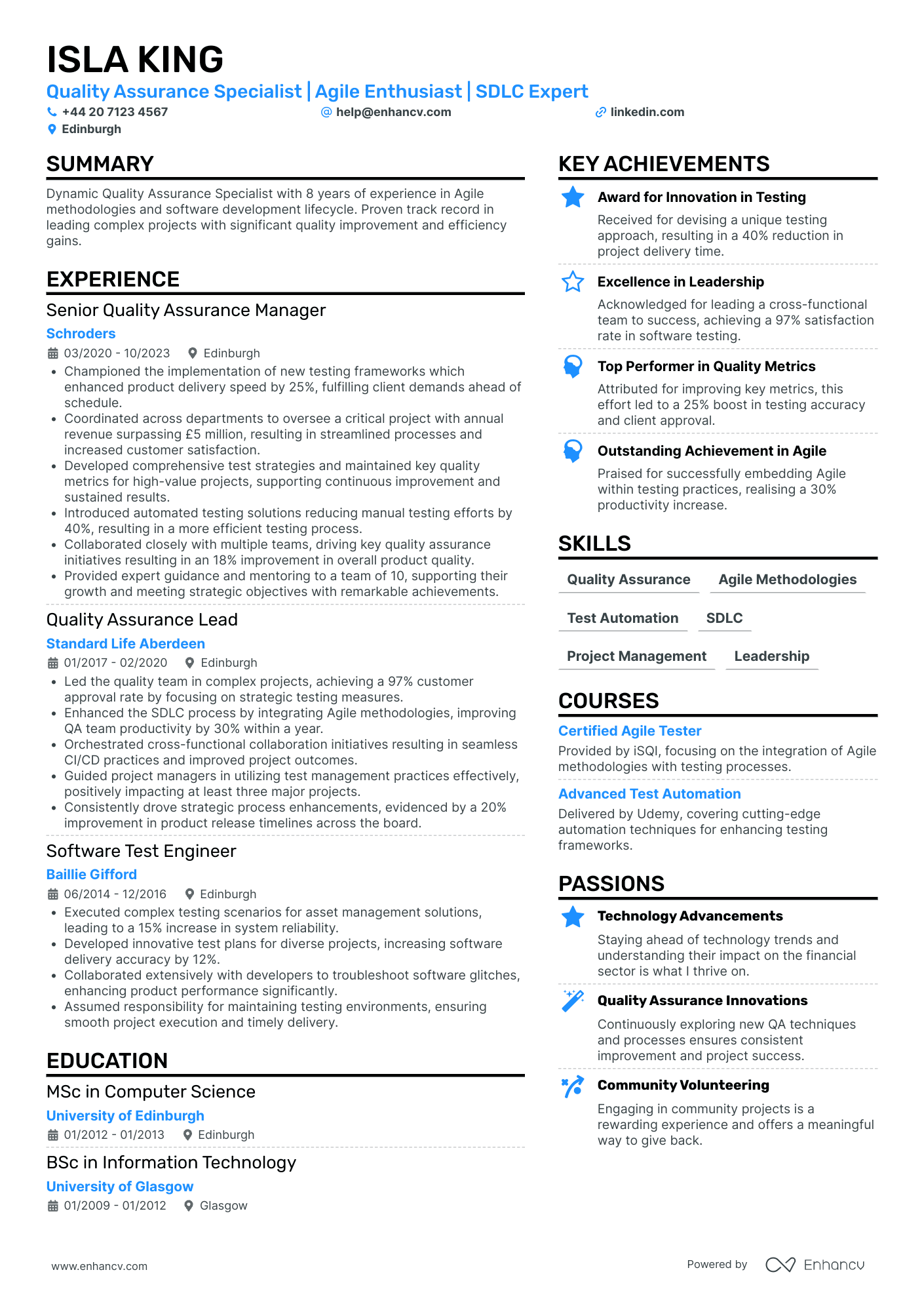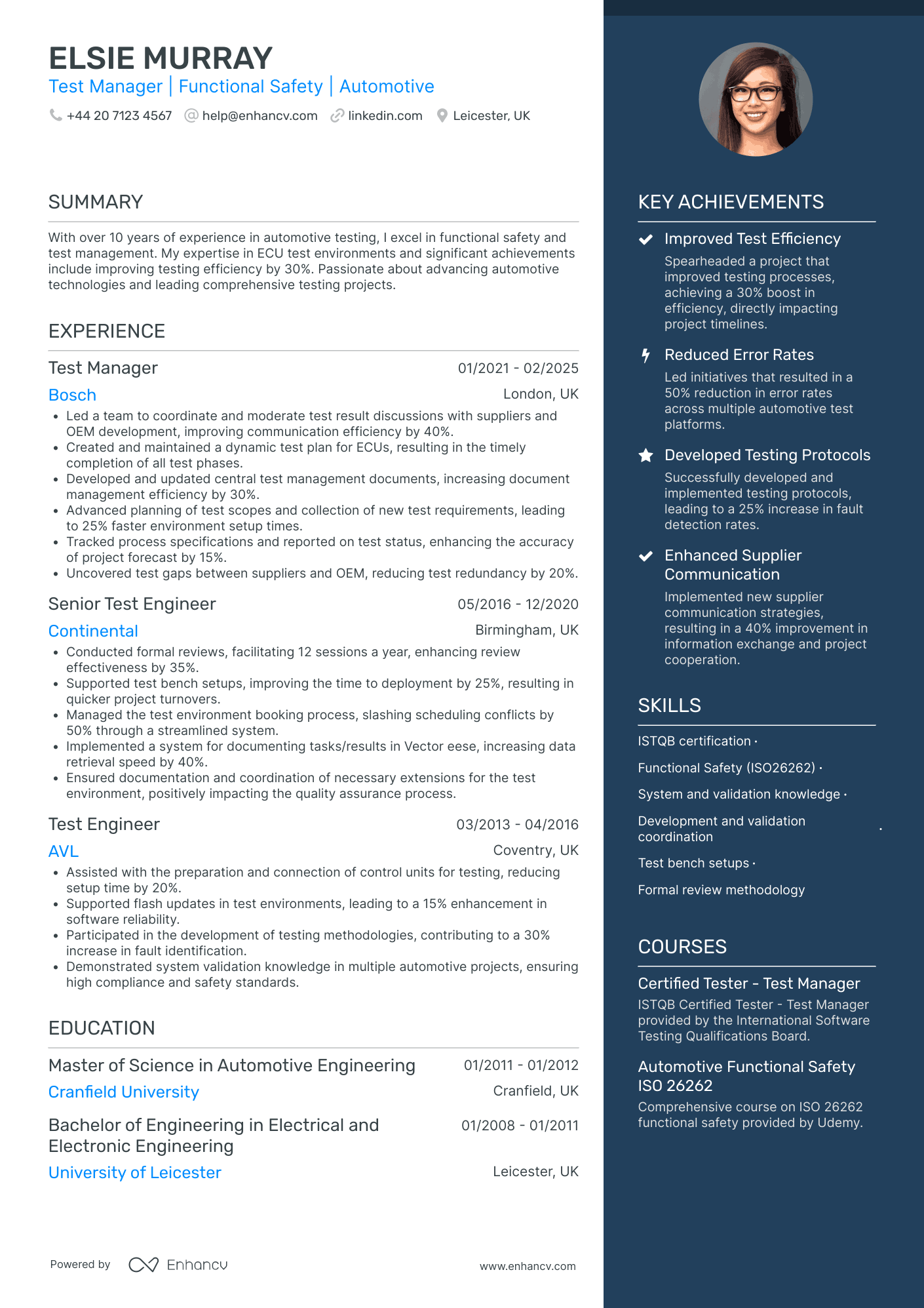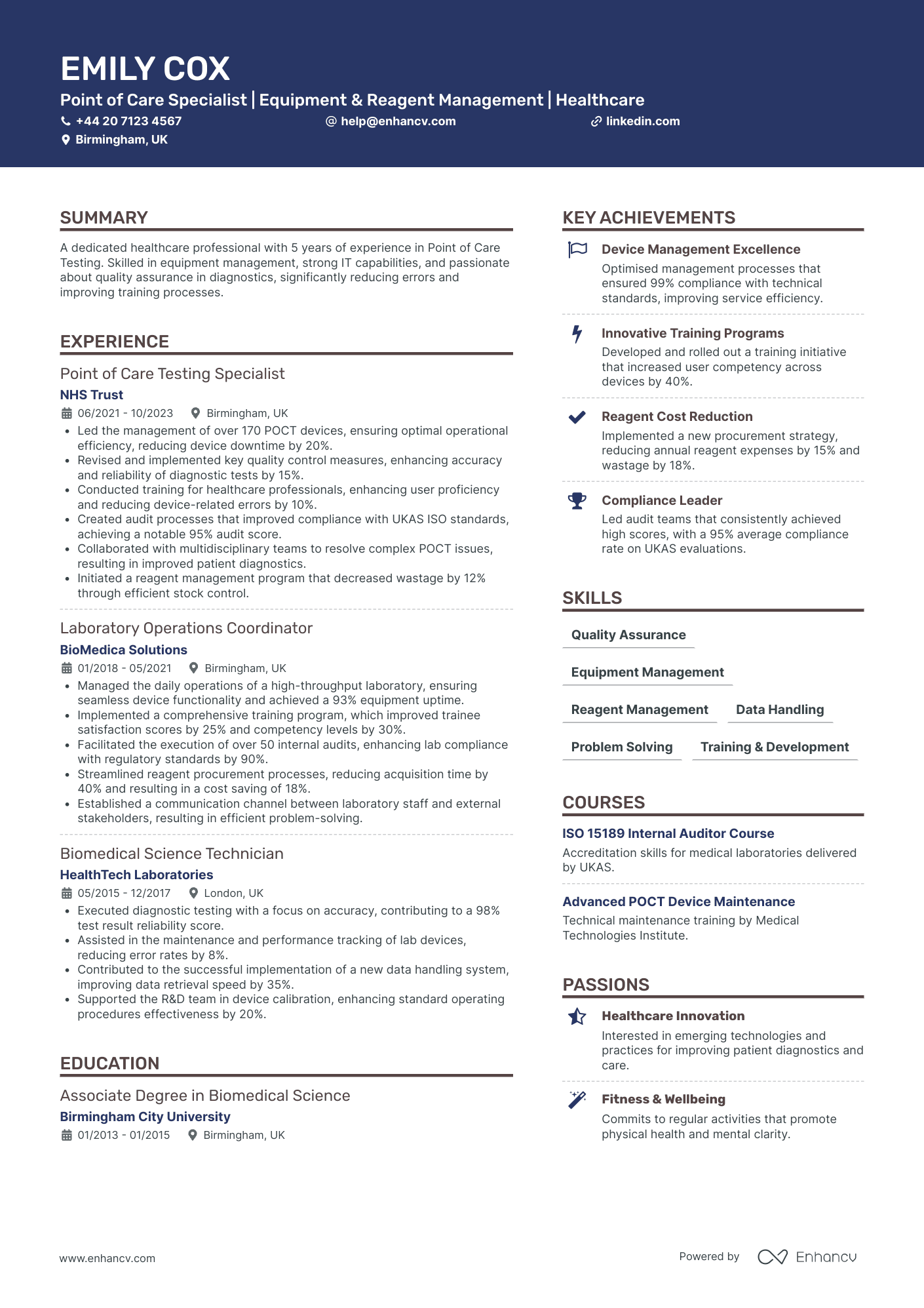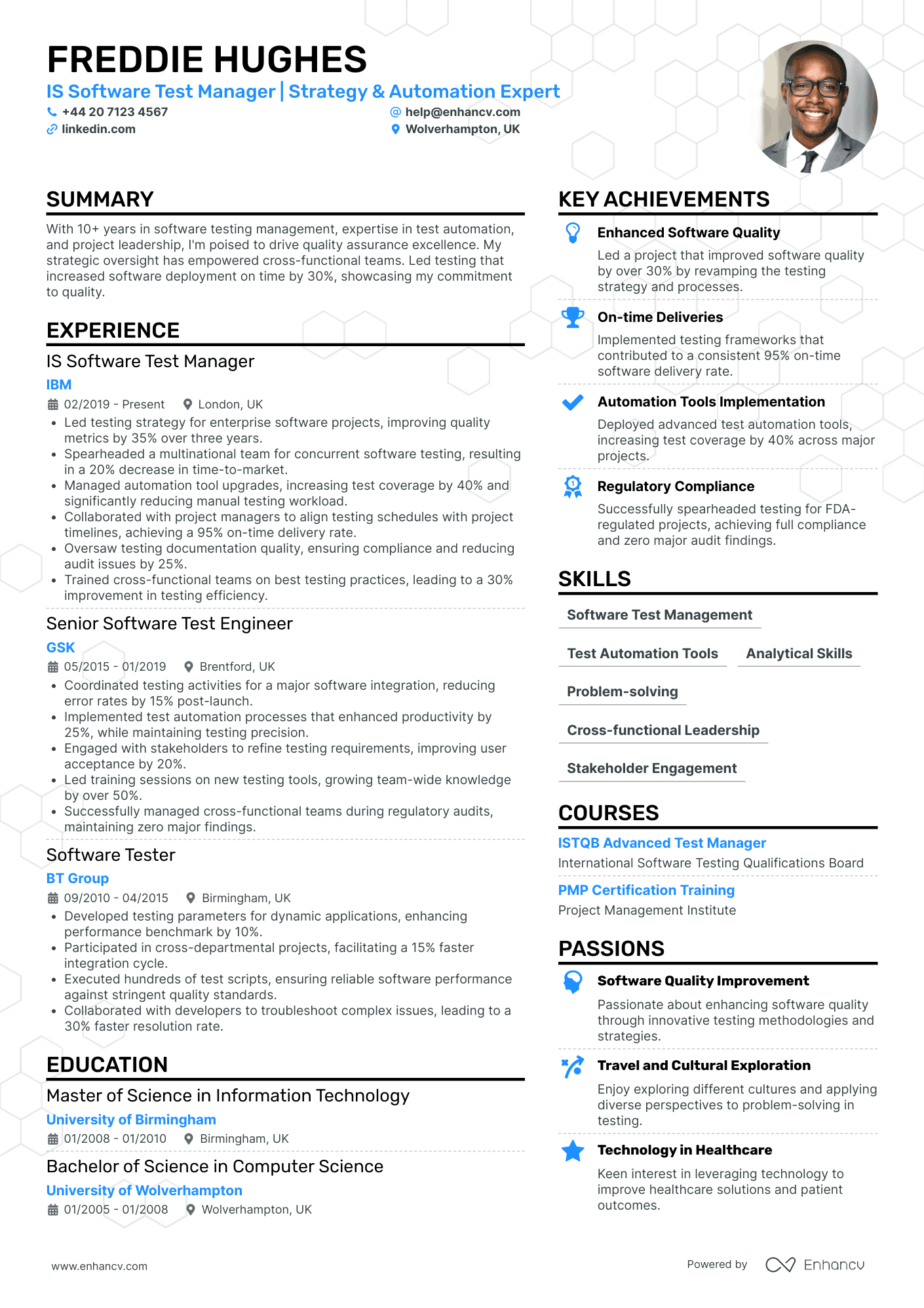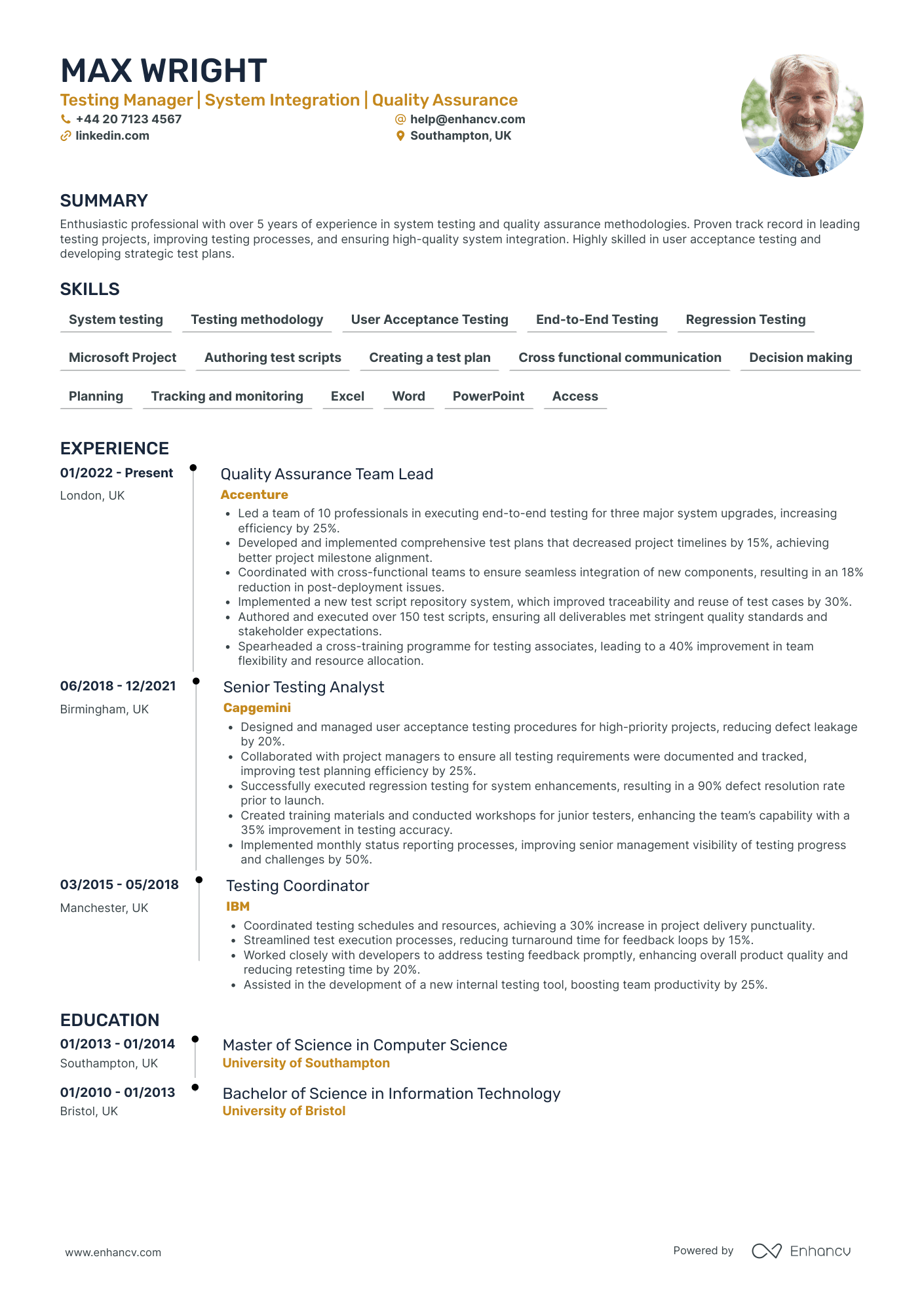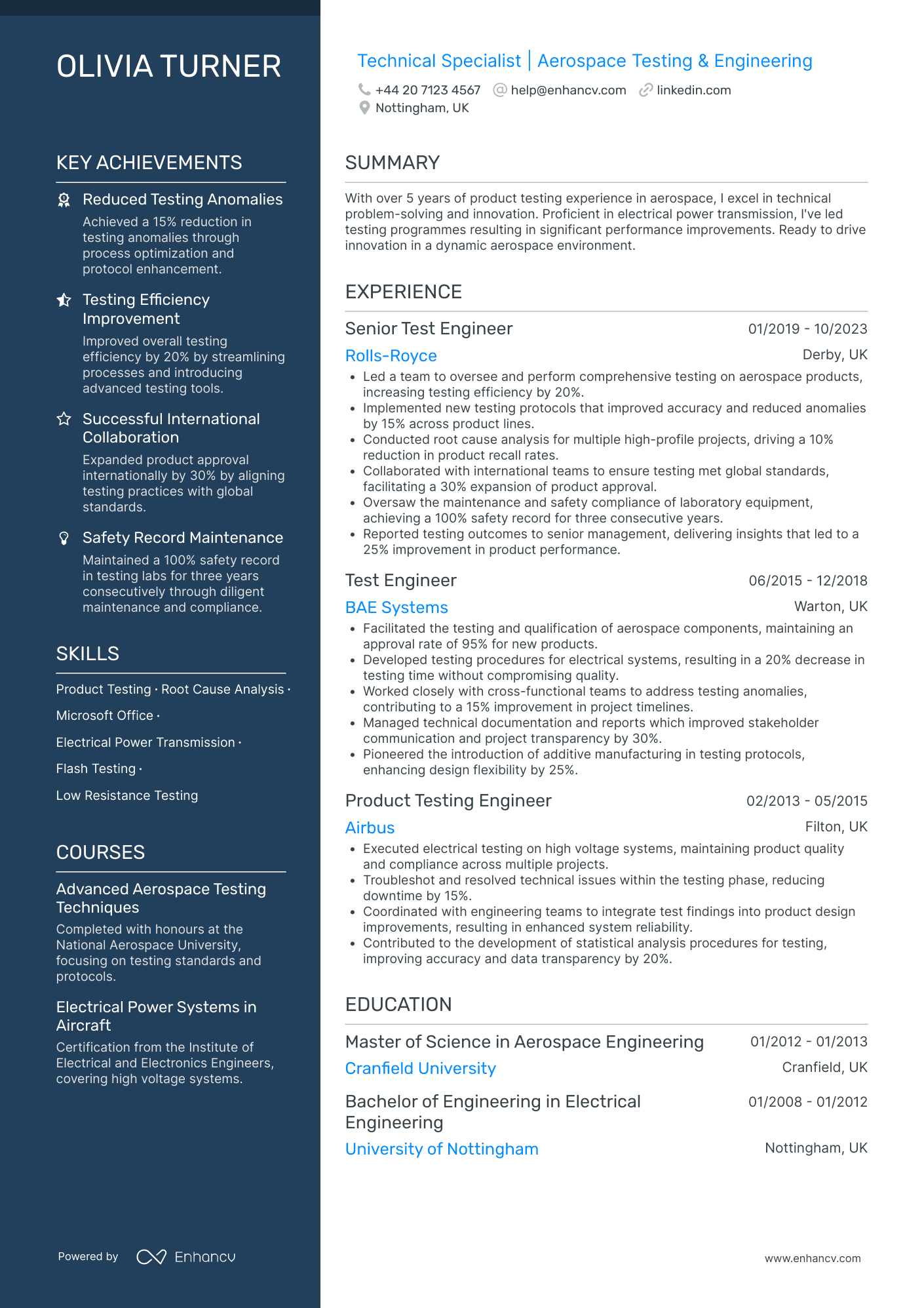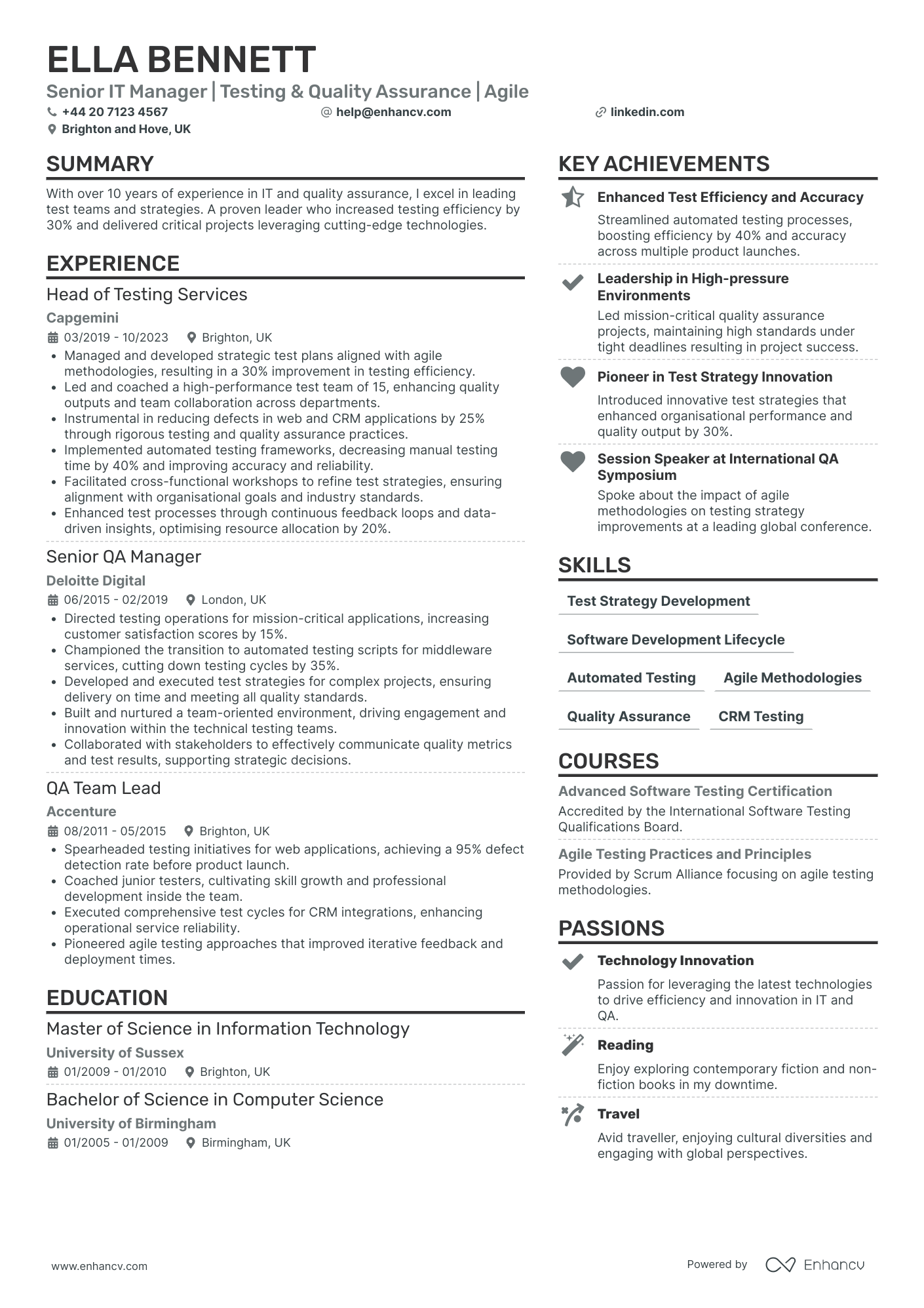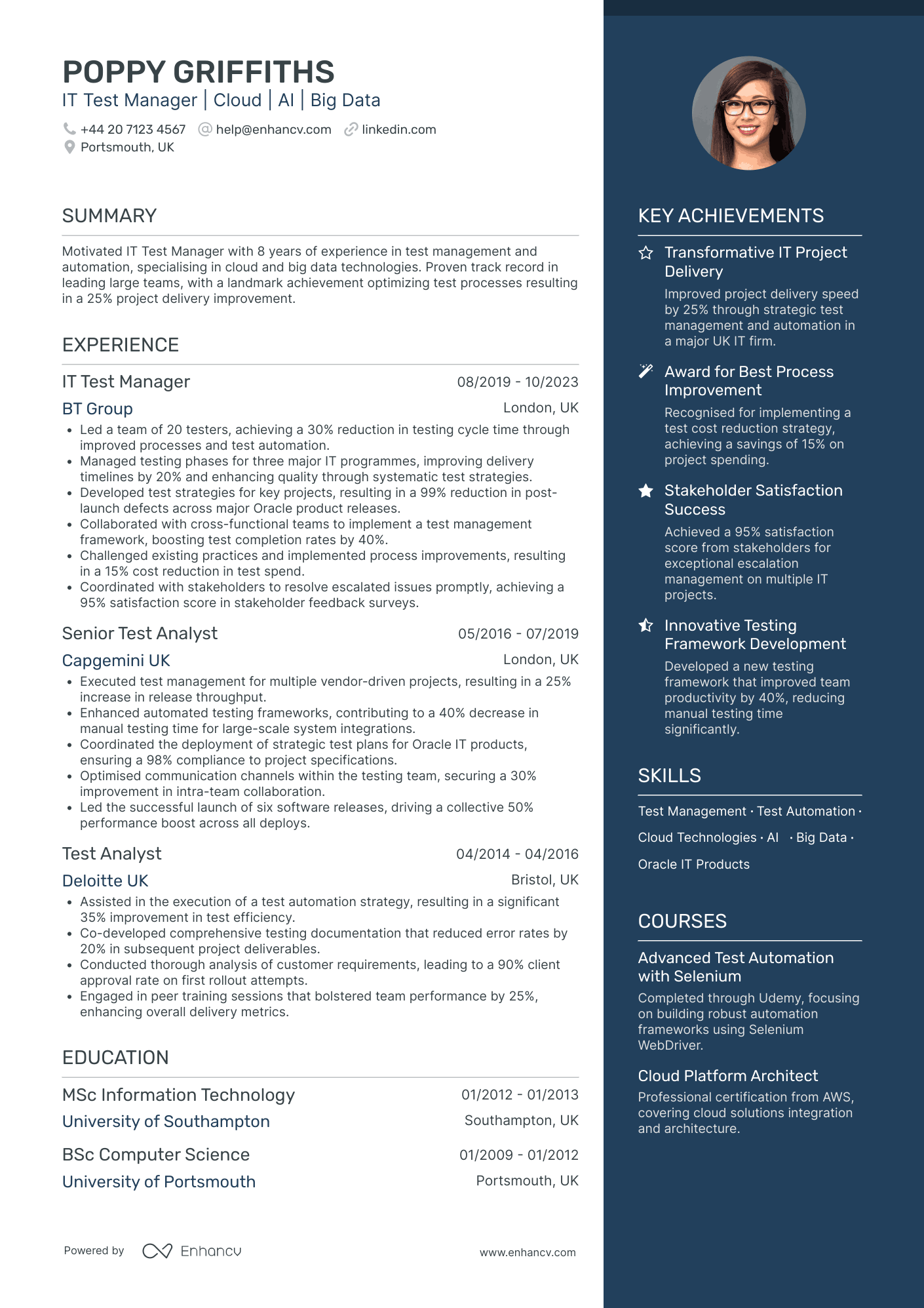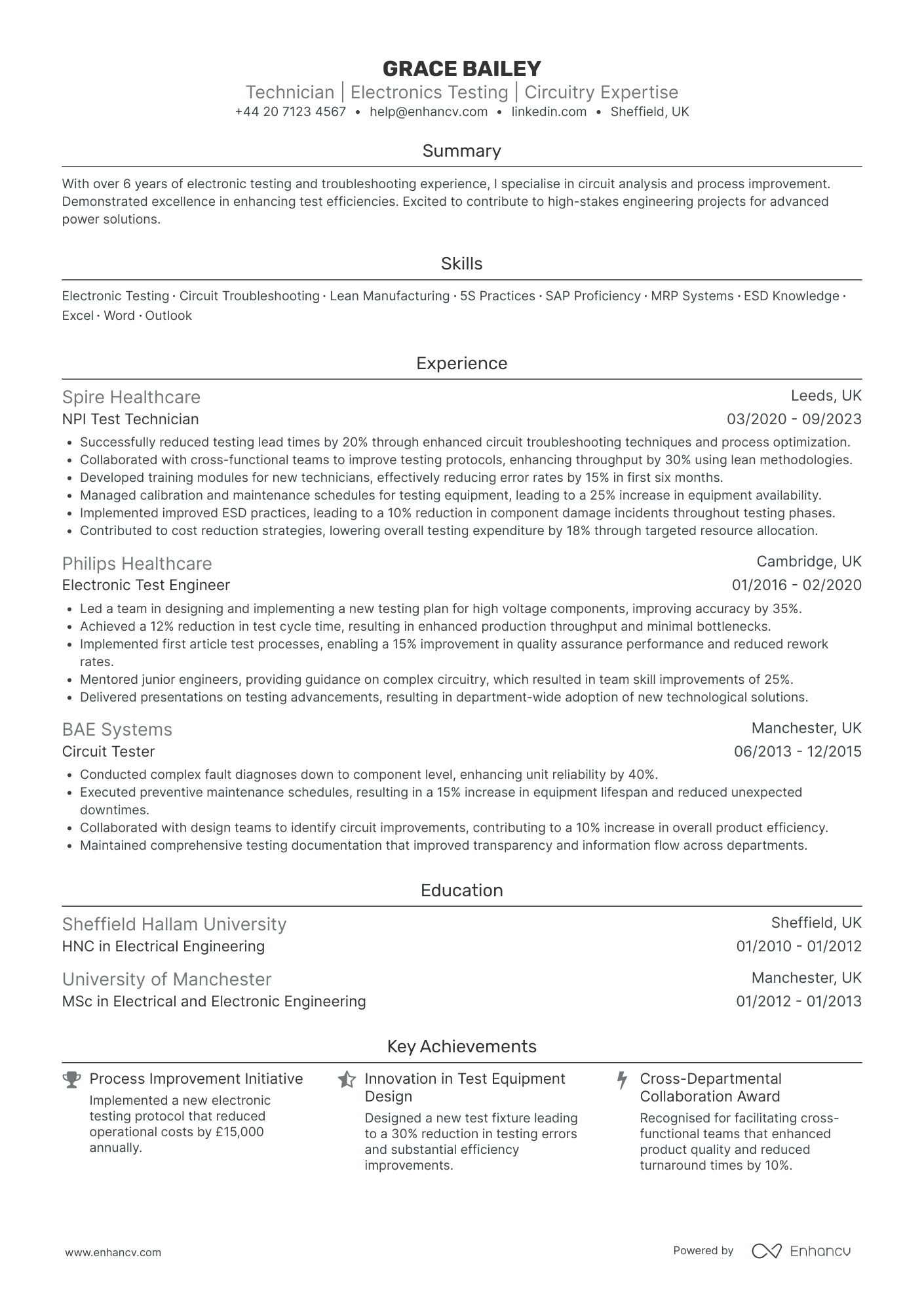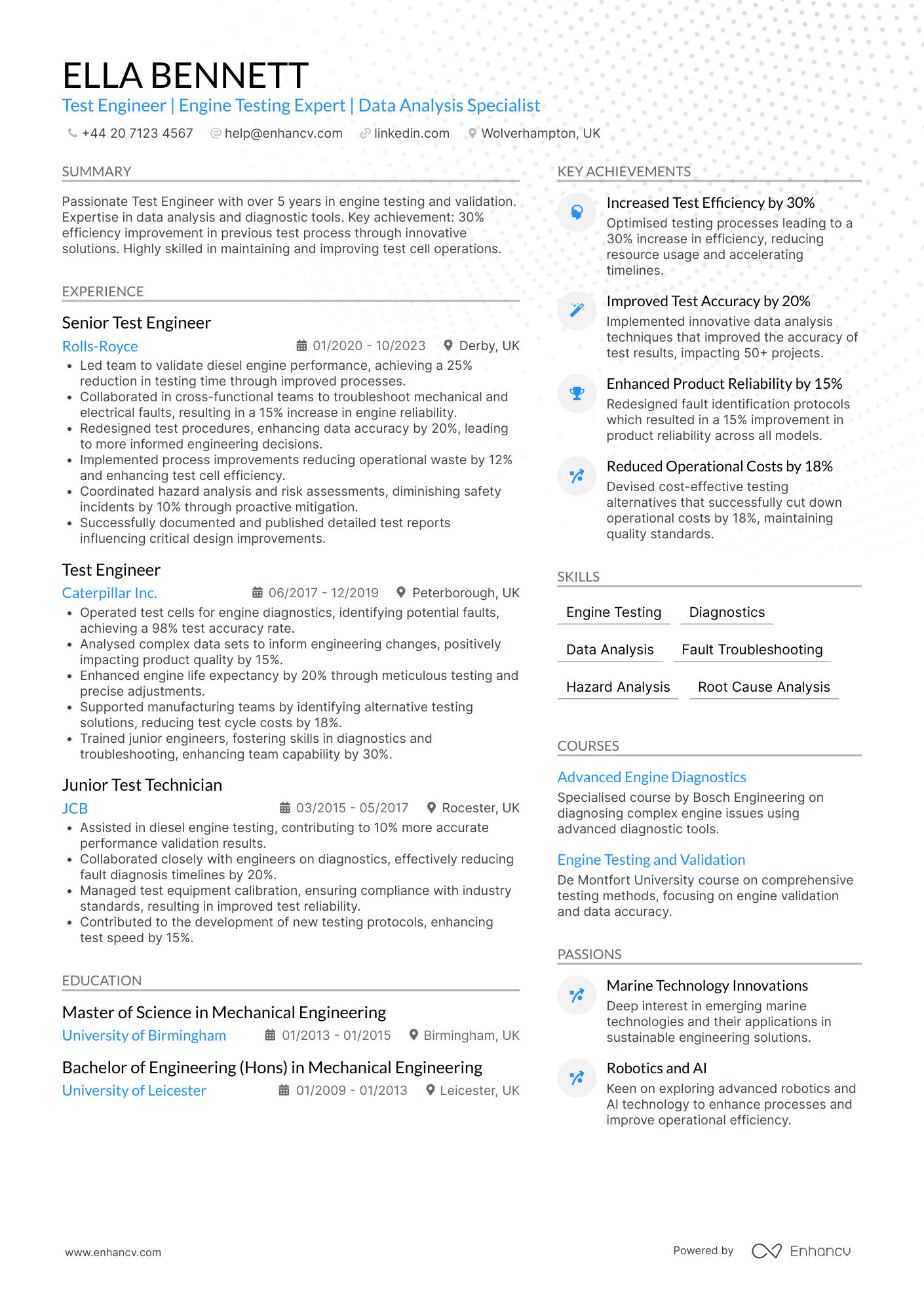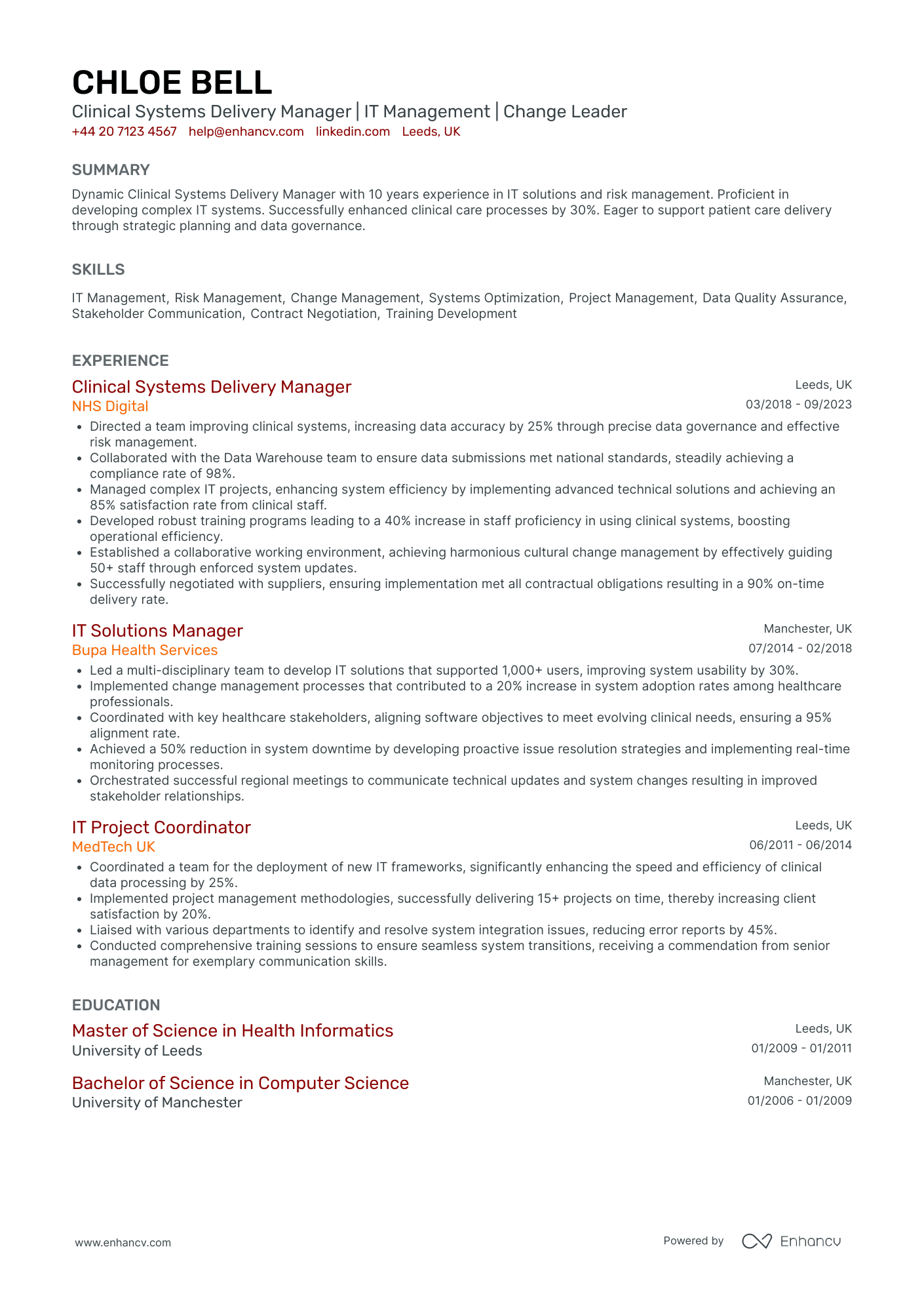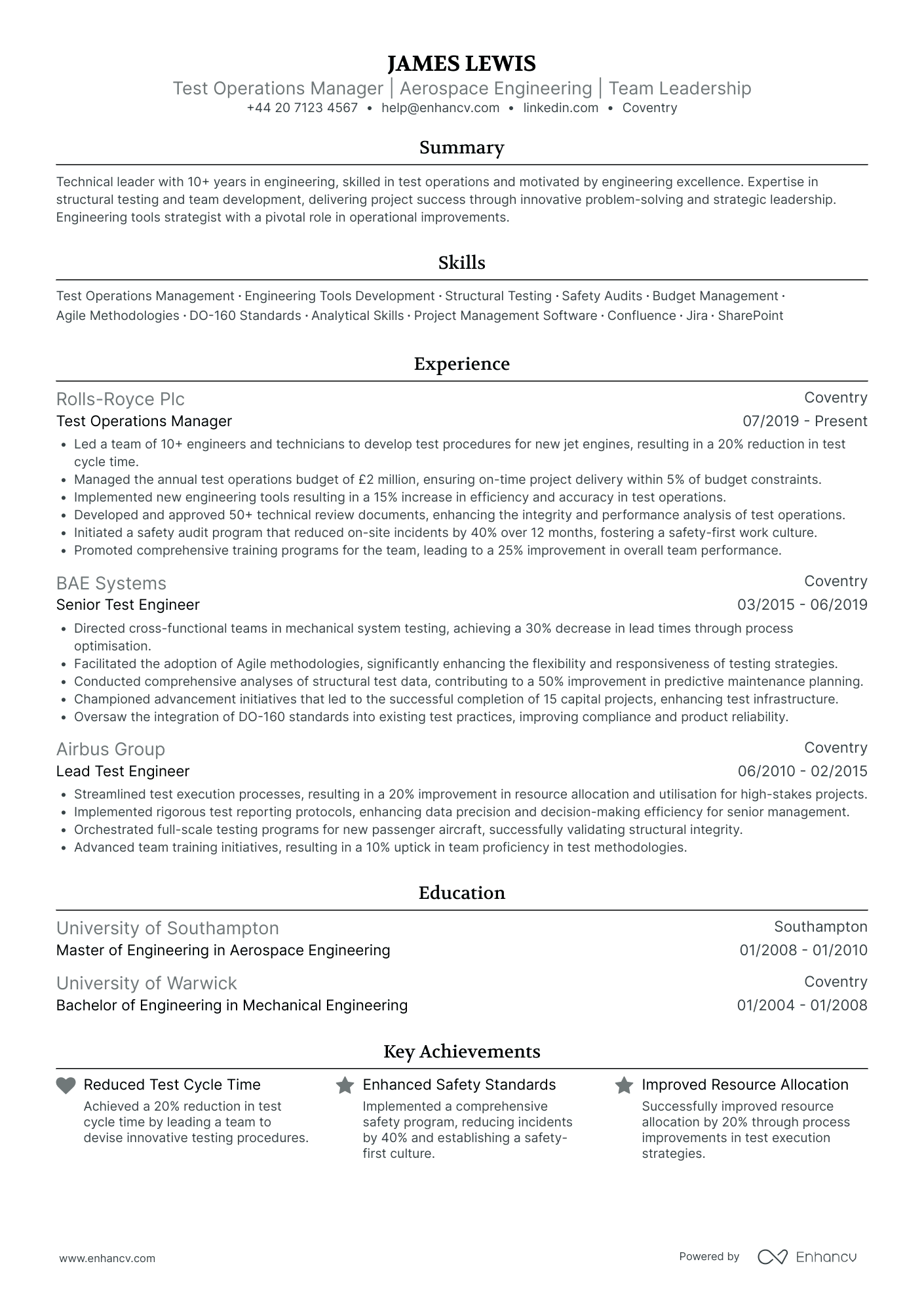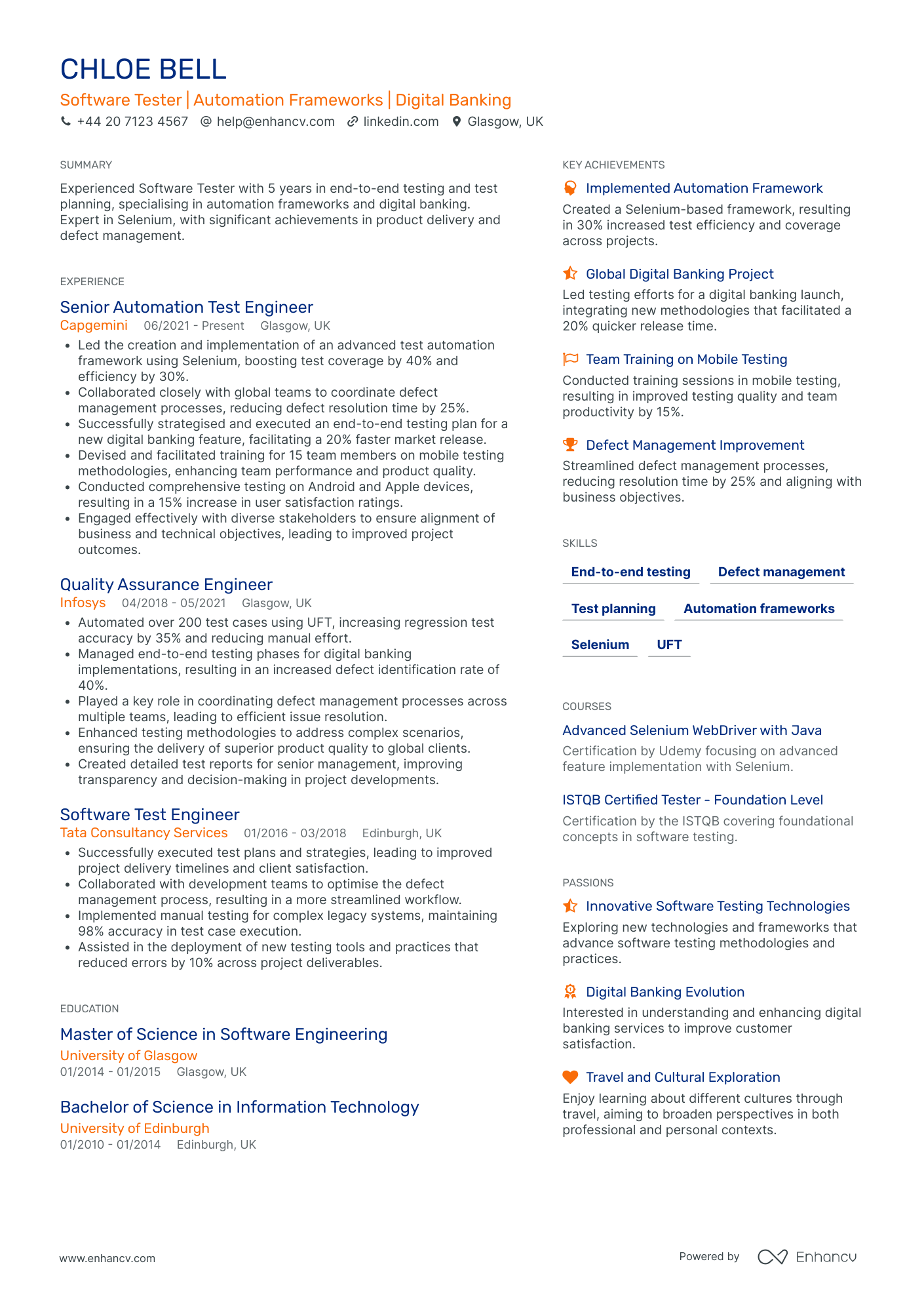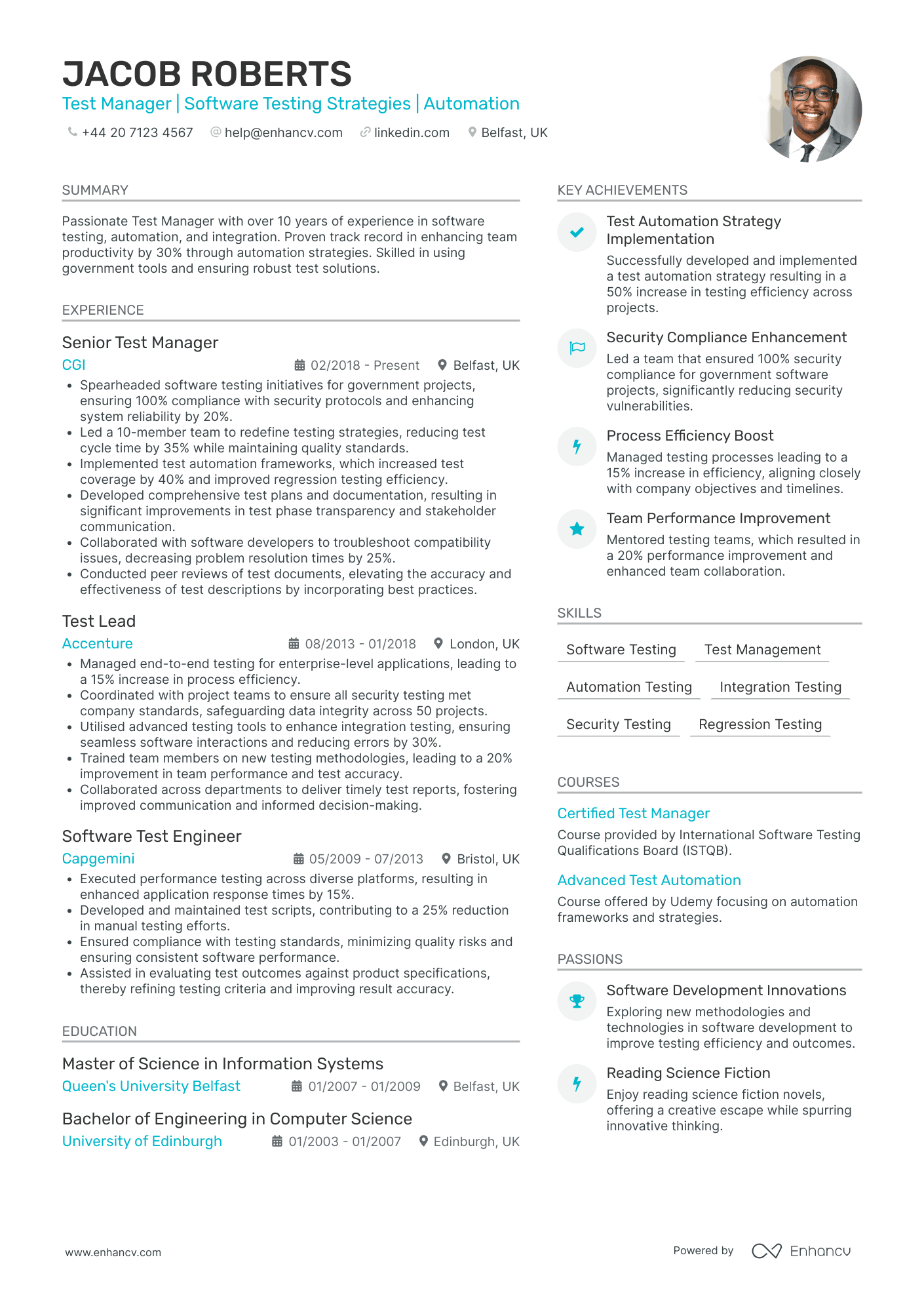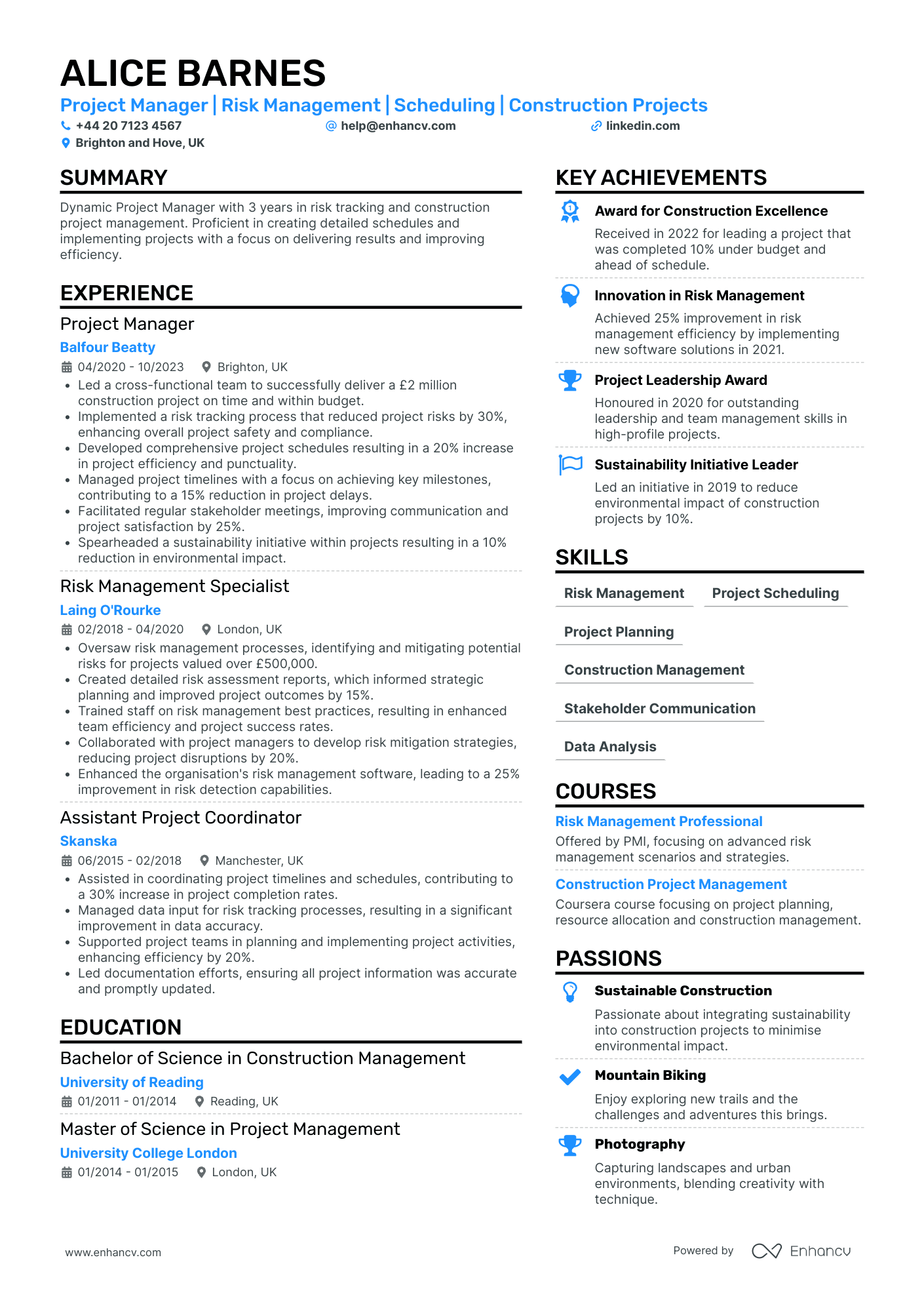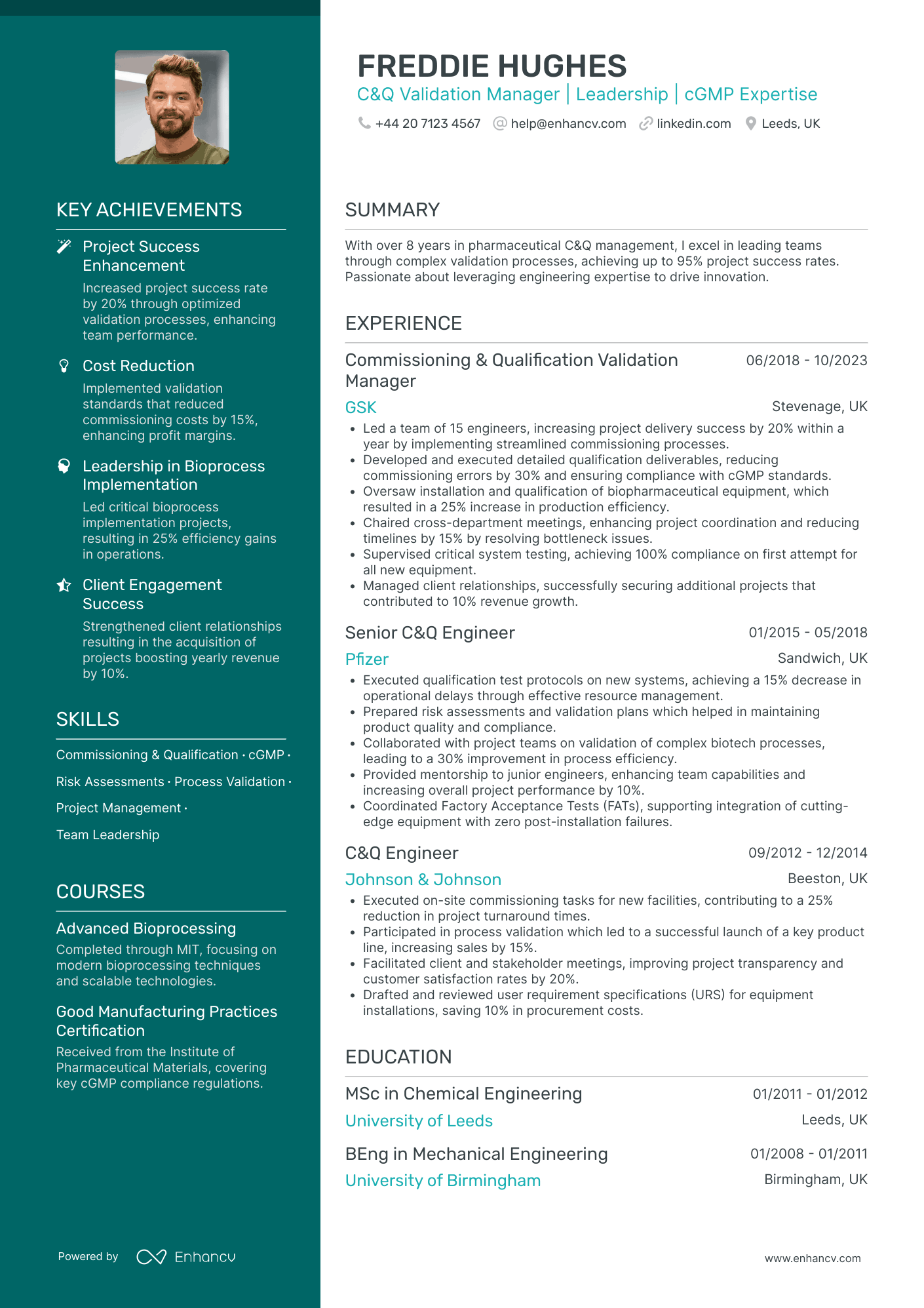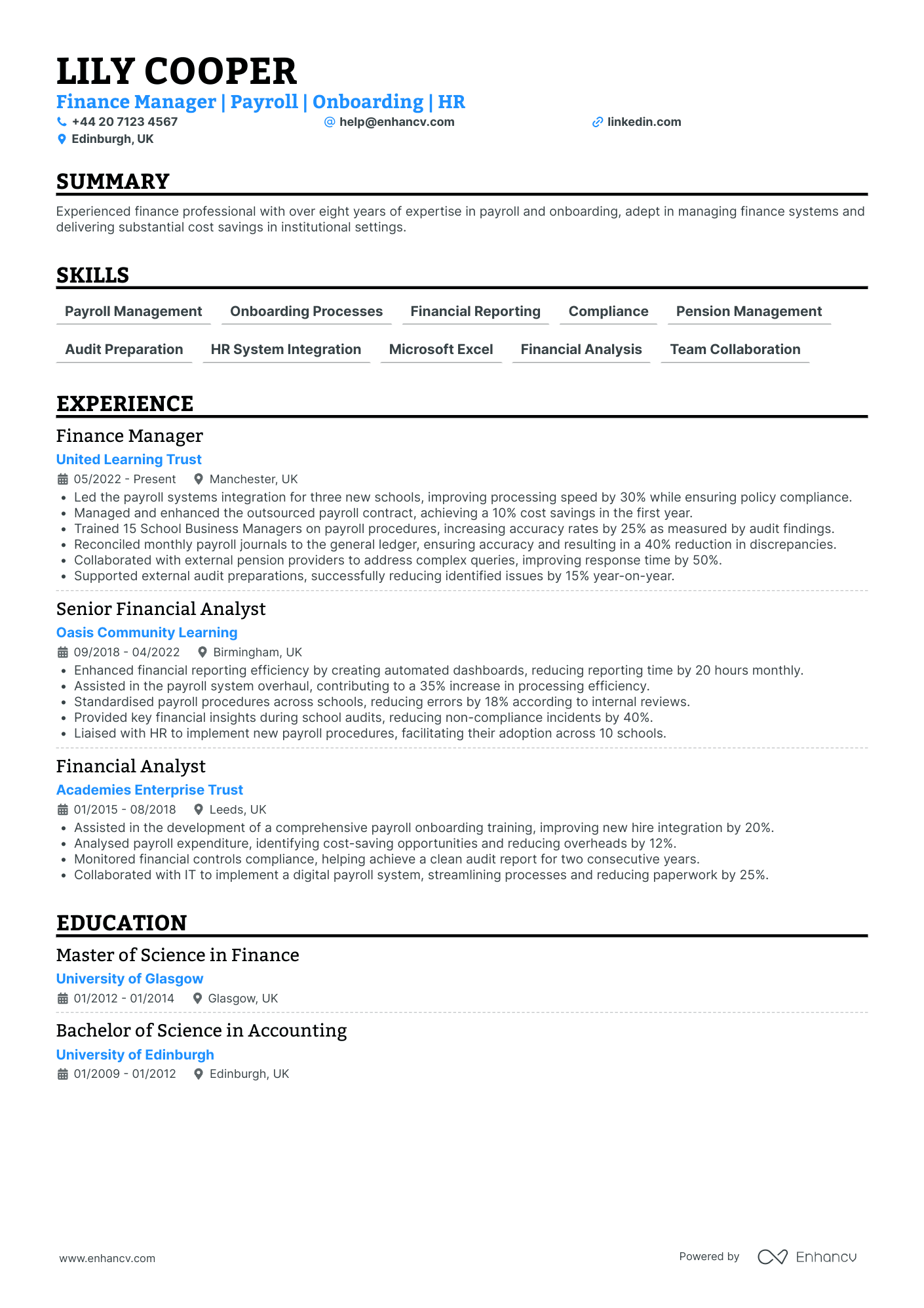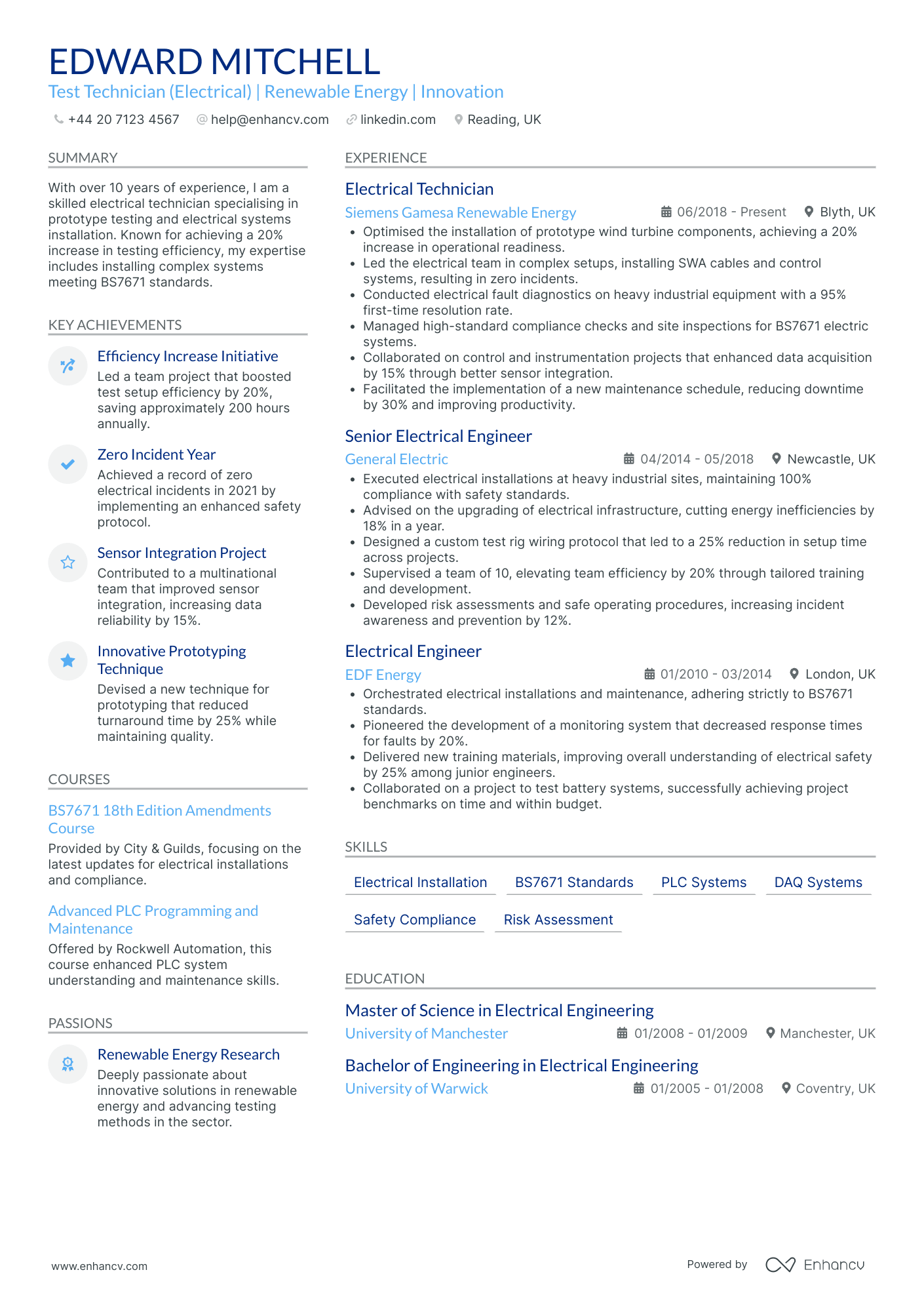Ensuring test coverage is comprehensive while remaining within tight deadlines is a significant CV challenge you might encounter. Our guide provides structured strategies to optimise your testing process, enabling you to maximise test coverage efficiently.
- Answer job requirements with your test manager CV and experience;
- Curate your academic background and certificates, following industry-leading CV examples;
- Select from +10 niche skills to match the ideal candidate profile
- Write a more succinct experience section that consists of all the right details.
Do you need more specific insights into writing your test manager CV? Our guides focus on unique insights for each individual role:
CV examples for test manager
By Experience
Senior Test Manager
- Structured and Concise Presentation - The CV is effectively organized into clear sections, allowing for easy navigation and comprehension of Thomas Walker's qualifications. Sections like 'Experience', 'Education', and 'Skills' are presented succinctly, highlighting key career milestones and expertise without overwhelming the reader with unnecessary details.
- Progressive Career Trajectory - Thomas Walker exhibits a strong career progression within the semiconductor industry, evolving from a Semiconductor Test Engineer to a Senior Semiconductor Engineer. This steady advancement reflects his capability, increasing responsibilities, and recognition within the field, underscoring his leadership in yield optimization and IC testing.
- Industry-Specific Technical Depth - The CV stands out for its focus on industry-specific methodologies and tools like ATE platforms, IC characterisation, and System Level Testing. Such technical depth, including areas like VLSI technologies and mixed-signal circuits, establishes Walker’s expertise and capability in tackling complex engineering challenges.
Junior Test Manager
- Clear Structure and Conciseness - The CV is well-organized with distinct sections for each aspect of the candidate's professional background. It maintains clarity and conciseness by using bullet points to summarize key responsibilities and achievements, making it easy for the reader to grasp the candidate's skill set and experience.
- Career Growth and Skill Expansion - James has shown a progressive career trajectory from a Project Assistant to a Junior Project Manager within four years. Each role has involved increasingly complex responsibilities, highlighting his aptitude for quickly adapting to new challenges and environments, while consistently improving his skill set in managing integrated campaigns.
- Robust Use of Methodologies and Tools - Demonstrating depth in industry-specific methodologies, James effectively utilizes project management tools like Trello and Asana. Additionally, his Agile Project Management Certification indicates a strong grasp of adaptive techniques suitable for managing modern integrated campaigns.
Lead Test Manager
- Comprehensive Structure and Clarity - The CV is well-organized, presenting information in a clear and concise manner. Each section is distinct and logically arranged, making it easy for recruiters to navigate through the candidate’s qualifications, experience, and skills. The use of bullet points in the experience section highlights achievements and responsibilities efficiently, allowing for quick assimilation of key facts.
- Career Progression and Leadership - The career trajectory depicted in the CV shows significant growth from a Software Test Engineer to a Senior Quality Assurance Manager within a span of less than a decade, highlighting the candidate's upward mobility and leadership capabilities. Demonstrating a proven record of guiding teams and leading projects across various roles indicates resilience and adaptability in an evolving industry.
- Specialized Industry Expertise and Certifications - The CV stands out by emphasizing the candidate’s deep knowledge in Agile methodologies and SDLC, which are crucial in the IT industry. The inclusion of relevant certifications like Certified Agile Tester and Advanced Test Automation, combined with practical experience in automation and process improvement, provides a solid foundation for the candidate's expertise in quality assurance.
Principal Test Manager
- Comprehensive and Structured Presentation - The CV is exceptionally well-organized, with a clear structure that allows each section to effectively communicate its purpose. Concise bullet points in the experience section make the information digestible, while the use of percentages to highlight achievements immediately demonstrates the candidate's impact.
- Industry-Specific Methodologies and Tools - Elsie Murray’s experience is deeply rooted in specialized automotive testing environments, with references to specific tools like Vector eese and her proficiency in bus communication protocols such as Ethernet and CAN. Her mastery of these tools illustrates a technical depth crucial for the automotive sector, particularly in functional safety and testing protocols.
- Leadership and Interpersonal Skills - The CV demonstrates Elsie's ability to lead teams and improve communication efficiency, as evidenced by her achievements in enhancing supplier interactions by 40%. Her role in moderating test discussions underscores her soft skills, illustrating her effectiveness in complex, cross-functional environments.
Associate Test Manager
- Clear and Functional Structure - The CV is structured in a way that clearly delineates different sections such as experience, education, skills, and achievements, providing a comprehensive yet concise overview of the candidate’s professional background and accolades. This clarity ensures that the key information is easy to navigate and digest.
- Progressive Career Path - Emily Cox’s career trajectory demonstrates a clear progression from a Biomedical Science Technician to a specialist role in Point of Care Testing. This upward movement signifies a continuous quest for professional growth and a deepening specialization within the healthcare domain.
- Innovative Tools and Management Techniques - The CV highlights specific methodologies and technical tools employed by the candidate, including efficient stock control programs and the implementation of UKAS ISO compliance measures. These elements underscore Emily's technical depth and familiarity with industry-specific processes critical to her role.
By Role
Software Test Manager
- Clarity and Structured Content Presentation - Freddie Hughes's CV is well-organized, with clear sections that delineate his extensive experience, skills, and qualifications. The structure is logical and easy to follow, effectively guiding the reader through his career history and achievements, ensuring that key information stands out immediately.
- Career Growth and Progression - The CV highlights a clear trajectory from Software Tester to IS Software Test Manager, showcasing Freddie's growth within the software testing field. His career progression reflects increasing responsibilities, leadership roles, and a broadened scope of projects, highlighting his capability to evolve with industry demands.
- Industry-Specific Achievements and Impact - Freddie's achievements are not just numeric but show a profound impact on business outcomes, such as improving software deployment efficiency by 30% and enhancing quality metrics by 35%. His technical contributions in deploying advanced test automation tools demonstrate his strategic influence on operational efficiency and quality assurance excellence.
Test Manager in Biotechnology
- Clear and Structured Presentation - The CV is meticulously organized, beginning with a comprehensive header that concisely presents essential contact information and personal details. Each section, including experience, education, and skills, is well-delineated, providing a streamlined reading experience. Beyond clarity, the logical flow from current to past roles aids in easy comprehension of the candidate's professional journey.
- Demonstrated Growth and Leadership - Max Wright's career progression is noteworthy, moving from roles as a Testing Coordinator to a Senior Testing Analyst, and now a Quality Assurance Team Lead. This trajectory not only illustrates ascension through increasing levels of responsibility but also underscores his capability to lead and mentor teams, as evidenced by his initiatives in cross-training and process improvements.
- Noteworthy Achievements and Impact - The CV emphasizes achievements with substantial impact on business operations, such as reducing project timelines by 15% and increasing team flexibility by 40%. These figures aren't merely statistical but are tied to strategic enhancements in testing processes and methodologies, demonstrably contributing to corporate efficiency and project success.
Test Manager for Data Systems
- Strategically Structured Content - Olivia Turner's CV is impressively structured, presenting information in a logical and concise manner that makes it easy for readers to follow her career trajectory and accomplishments. Each section is clearly demarcated, ensuring that key details such as experience, education, and skills are immediately visible to hiring managers.
- Consistent Career Advancement - Olivia’s career journey demonstrates consistent growth within the aerospace industry, marked by her transition from a Product Testing Engineer at Airbus to a Senior Test Engineer at Rolls-Royce. This progression highlights her capability to take on increasing responsibilities and her dedication to advancing within her field.
- Notable Achievements with Business Impact - The CV emphasizes Olivia's significant achievements, such as a 15% reduction in testing anomalies and a 20% improvement in testing efficiency. These accomplishments not only signify her technical prowess but also underscore her ability to contribute meaningfully to business outcomes, improving product performance and customer satisfaction.
Quality Assurance Test Manager
- Progressive Career Advancement - Ella Bennett's career trajectory displays a clear upward movement, starting from a QA Team Lead at Accenture to a Senior QA Manager at Deloitte Digital, and finally ascending to a Head of Testing Services at Capgemini. This progression showcases her growing responsibilities and trust within the industry, affirming her leadership capabilities and expertise in IT and quality assurance.
- Integration of Cutting-edge Technologies - The CV highlights Bennett's proficiency in leveraging the latest technologies to enhance testing processes, notably through automated testing frameworks that reduced manual testing by 40%. Her focus on adopting innovative tools underscores her commitment to staying ahead of industry trends and maintaining robust quality assurance practices.
- Effective Leadership and Team Development - Bennett's leadership prowess is evident in her ability to lead and coach high-performance test teams, fostering a collaborative environment across departments. Her active role in nurturing team-oriented dynamics and emphasizing skill growth among junior testers reflects her dedication to empowering team members and driving collective success.
Cybersecurity Test Manager
- Clear and Structured Presentation - The CV presents information in a concise and organized manner, utilizing clear section headers to categorize content effectively. Each experience and education entry is detailed with concise bullet points that quickly convey the candidate’s accomplishments and responsibilities, allowing readers to assimilate crucial information seamlessly.
- Progressive Career Development - Over the span of nearly a decade, Poppy Griffiths has consistently advanced in her career, moving from a Test Analyst to a Senior Test Analyst, and finally to an IT Test Manager. This trajectory showcases a clear pattern of upward mobility, reflecting her ability to adapt to complex roles and assume greater responsibilities within the IT sector.
- Technical Proficiency in Emerging Technologies - The CV is distinguished by its focus on industry-relevant technologies such as cloud platforms, AI, and big data. Poppy’s ability to integrate these technologies into her test management strategies highlights her technical depth and her commitment to staying ahead in the ever-evolving IT landscape.
Test Manager in Telecommunications
- Effective Content Structuring and Clarity - Grace Bailey's CV presents information in a clear, organized manner that allows for easy understanding of her professional journey. The structured sections, including a summary, experience, education, and skills, make it simple for the reader to grasp her qualifications and achievements quickly.
- Strong Career Progression and Growth - The CV articulates a clear trajectory of career advancement within the electronics testing and engineering field. Starting as a Circuit Tester and advancing to an NPI Test Technician, Grace demonstrates significant growth and increased responsibilities, including leadership roles in process and protocol improvements.
- Demonstrated Impact Through Achievements - Grace's CV effectively communicates the real-world impact of her contributions. Her achievements, such as reducing operational costs by £15,000 annually and improving testing process efficiencies, provide tangible benefits to her employers and highlight her ability to drive significant business outcomes.
Automotive Test Manager
- Clear and Structured Content Presentation - Ella Bennett's CV is clearly laid out, with sections distinctly separated, making it easy for hiring managers to quickly glean important information. Each section uses bullet points for concise descriptions, ensuring her key responsibilities and achievements are straightforward and highlighted.
- Strong Career Growth in the Engineering Sector - Ella's career trajectory shows clear advancement from a Junior Test Technician to a Senior Test Engineer within two leading industry companies. This progression demonstrates her growth in skills and responsibilities, indicating a commitment to career development and excellence in the field.
- Use of Industry-Specific Tools and Methodologies - The CV highlights Ella's expertise with advanced diagnostic tools and engine testing methodologies, which are critical in her industry. Her role in implementing process improvements and redesigning test procedures showcases her technical depth and initiative in enhancing operational processes.
Clinical Test Manager
- Structured and detailed content presentation - The CV is organized in a clear manner, with each section and bullet point conveying precise information. This clarity ensures that the reader can quickly grasp the candidate's skills, experience, and accomplishments without wading through unnecessary verbosity, effectively communicating a wealth of experience in a compact format.
- Career trajectory shows focused growth in healthcare IT - The progression from an IT Project Coordinator to the Clinical Systems Delivery Manager within the healthcare sector illustrates a deliberate and successful career path. This not only indicates professional growth but also highlights a deepening of specialization in healthcare informatics, making the candidate ideally suited for roles in this niche field.
- Soft skills and leadership clearly emphasized - Leadership is prominently showcased, with examples such as directing teams, developing training programs, and establishing collaborative environments. These points highlight the candidate's ability to lead cross-functional teams effectively, manage cultural changes, and negotiate with suppliers, integral qualities for a Clinical Systems Delivery Manager.
Test Manager in Aerospace Engineering
- Clear Structure and Conciseness - The CV is presented with a clear and well-organized structure, allowing each section to emphasize key qualifications, experiences, and achievements. The use of bullet points aids in concise communication of complex information and impressive results.
- Steady Career Growth and Industry Commitment - The career trajectory in James Lewis's CV evidences a steady progression in the aerospace industry, demonstrating growth from a Lead Test Engineer at Airbus Group to Test Operations Manager at Rolls-Royce. This reflects a strong commitment to advancing within his field.
- Industry-Specific Expertise in Testing and Engineering Tools - James showcases a deep technical depth in aerospace engineering through his experience with engineering tool development, implementation of DO-160 standards, and structural testing. These elements are crucial for demonstrating his unique expertise and impact in the aerospace sector.
Test Manager for Mobile Applications
- Structured Career Progression - Chloe Bell's CV demonstrates a clear and strategic career advancement within the software testing industry, highlighting promotions from Software Test Engineer to Senior Automation Test Engineer. This progression reflects her ability to rapidly adapt and excel in increasingly complex roles within leading firms such as Capgemini and Infosys, indicating strong competencies and leadership capabilities.
- Technical Proficiency in Industry-Specific Tools - The CV emphasizes Chloe's expertise with critical automation tools like Selenium and UFT, along with her contributions to innovative frameworks in digital banking. These industry-specific skills underscore her technical acumen, which is further supplemented by advanced certifications like the ISTQB and comprehensive training in Selenium WebDriver, enhancing her value as a specialized tester.
- Significant Achievements with Business Impact - Chloe outlines not only her personal achievements but also how they translate into tangible business outcomes, such as reducing defect resolution time by 25% and boosting test coverage by 40%. These accomplishments reflect her focus on delivering efficiency improvements and faster market releases, aligning her contributions with key business objectives.
Infrastructure Test Manager
- Strategic clarity and structured articulation - Jacob Roberts’ CV is meticulously crafted with a structure that highlights his experience and skills in a logical flow. Each section is concise, presenting information in an easy-to-understand manner, ensuring the essential details are immediately accessible to recruiters.
- Robust career development - Roberts' career trajectory is impressive, reflecting consistent growth through promotions from a Software Test Engineer to a Senior Test Manager role. His journey showcases a dedication to mastering the testing domain and moving up the ranks within reputed companies such as Capgemini, Accenture, and CGI.
- Technical acumen and industry-specific expertise - The CV shines with Jacob's profound grasp on software testing and automation tools, especially in government projects. His ability to lead initiatives that enhance system reliability and security compliance showcases his depth and vitality in using industry-specific methodologies effectively.
Environment Test Manager
- Comprehensive Career Progression - Alice Barnes' CV clearly depicts a progressive career in construction and project management, showcasing a trajectory from an Assistant Project Coordinator to a Project Manager. This evolution highlights her dedication to advancing her expertise within the industry while taking on roles of increasing responsibility, making her a seasoned professional adept in her domain.
- Emphasis on Tangible Achievements - The CV effectively leverages specific achievements to demonstrate Alice's impact on her projects. Metrics such as reducing project risks by 30%, enhancing risk detection capabilities by 25%, and completing a high-budget project under budget reflect her ability to deliver substantial results and improve operational efficiencies, presenting her as a value-driven contributor in her field.
- Effective Use of Industry-Specific Tools - The skill section underscores Alice's proficiency in critical construction and project management software such as Microsoft Project, AutoCAD, and Primavera P6. This highlights her technical acumen and ability to leverage specialized tools to drive project success and manage complex scheduling and planning tasks, distinguishing her technical expertise within the industry.
Test Manager in Pharmaceutical Industry
- Structured career progression - The CV outlines a clear and gradual growth in responsibilities, from a C&Q Engineer to a managerial role, demonstrating the candidate's continuous professional development and leadership emergence within top pharmaceutical companies.
- Technical depth with specific methodologies - Noteworthy is the candidate's expertise in cGMP compliance and advanced bioprocessing techniques, underscoring their capability to manage complex biotech equipment and compliance-critical validation processes, essential for the pharmaceutical industry.
- Leadership and impact on team performance - Highlighting effective team leadership, the CV shows how the candidate enhanced team capabilities through mentorship and improved project success rates by implementing optimized validation processes, underlining a capacity to drive teams toward achieving organizational goals.
Test Manager for Financial Systems
- Structured and Concise Presentation - The CV is well-organized, making it easy to explore relevant experiences. Each section is logically structured, highlighting key accomplishments without overwhelming the reader with excessive detail. This approach ensures clarity while presenting a comprehensive view of the candidate’s qualifications.
- Continuous Career Progression - The candidate displays an impressive trajectory, evolving from a Financial Analyst to a Finance Manager role. Their experience spans multiple reputable organizations and locations, showcasing their ability to adapt and thrive in different environments, suggesting readiness for future leadership roles in finance and HR management.
- Industry-Specific Expertise and Tools - The CV emphasizes the candidate's familiarity with financial systems and payroll processes. Skills like payroll management and financial analysis are enhanced by technical proficiency in tools such as Microsoft Excel and digital payroll systems, demonstrating a deep understanding of industry-relevant methodologies and innovations.
Test Manager in Renewable Energy
- Career Development and Industry Focus - Edward Mitchell's CV demonstrates a clear career trajectory within the renewable energy and electrical engineering sectors. Beginning as an Electrical Engineer and advancing to roles with greater responsibility, such as Senior Electrical Engineer and Test Technician, the document outlines a steady progression and deepening expertise in this field. His long-term employment within top industry companies like Siemens and General Electric signifies a commitment to growing within renewable energy and electrical innovation.
- Technical Competencies and Industry-Specific Skills - Throughout the CV, Edward showcases his proficiency with industry-specific tools and standards like BS7671, which reflects his ability to adhere to and implement high-level compliance and safety measures. The mention of PLC and DAQ systems further highlights his technical depth and ability to work with complex control and instrumentation projects. This technical skillset is complemented by courses and recognized certifications, which serve to emphasize continual professional development.
- Impactful Achievements and Leadership Skills - The CV effectively highlights notable achievements and their broader business implications, such as implementing a maintenance schedule that reduced downtime by 30% and guiding projects that increased data acquisition. His leadership qualities are demonstrated through his roles in team supervision and training, driving operational and efficiency improvements while maintaining a high level of safety compliance. These accomplishments validate his capability to lead initiatives that deliver both safety and performance benefits, showcasing strong leadership and project management abilities.
How to ensure your profile stands out with your test manager CV format
It's sort of a Catch 22. You want your test manager CV to stand out amongst a pile of candidate profiles, yet you don't want it to be too over the top that it's unreadable. Where is the perfect balance between your CV format simple, while using it to shift the focus to what matters most. That is - your expertise. When creating your test manager CV:
- list your experience in the reverse chronological order - starting with your latest roles;
- include a header with your professional contact information and - optionally - your photograph;
- organise vital and relevant CV sections - e.g. your experience, skills, summary/ objective, education - closer to the top;
- use no more than two pages to illustrate your professional expertise;
- format your information using plenty of white space and standard (2.54 cm) margins, with colours to accent key information.
Once you've completed your information, export your test manager CV in PDF, as this format is more likely to stay intact when read by the Applicant Tracker System or the ATS. A few words of advice about the ATS - or the software used to assess your profile:
- Generic fonts, e.g. Arial and Times New Roman, are ATS-compliant, yet many candidates stick with these safe choices. Ensure your CV stands out by using a more modern, and simple, fonts like Lato, Exo 2, Volkhov;
- All serif and sans-serif fonts are ATS-friendly. Avoid the likes of fancy decorative or script typography, as this may render your information to be illegible;
- Both single- and double-column formatted CVs could be assessed by the ATS;
- Integrating simple infographics, icons, and charts across your CV won't hurt your chances during the ATS assessment.

PRO TIP
For certain fields, consider including infographics or visual elements to represent skills or achievements, but ensure they are simple, professional, and enhance rather than clutter the information.

The top sections on a test manager CV
- Professional Summary: Summarise your value proposition as a Test Manager.
- Key Skills: Highlight technical and leadership skills specific to testing.
- Professional Experience: Detail your test management and project lead roles.
- Education and Certifications: Include relevant degrees and testing certifications.
- Test Leadership Achievements: Show success in leading test teams and improving QA processes.
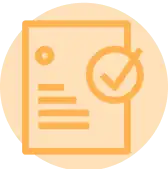
What recruiters value on your CV:
- Highlight your leadership experience by showcasing how you've successfully led testing teams and managed complex projects, emphasising the scale and the outcomes of such initiatives.
- Detail your proficiency with test management tools such as JIRA, TestRail, or HP ALM, and explain how your expertise enhanced workflow efficiency and accuracy in previous roles.
- Include specific metrics to demonstrate your effectiveness, such as test cycle reduction percentages, defect detection rates, or quality assurance improvements under your management.
- Showcase your strategic planning abilities by describing how you've developed and implemented test plans, methodologies, and processes that align with business goals and reduce risks.
- Emphasise your communication and collaboration skills by mentioning cross-functional initiatives and how you liaised between technical teams and stakeholders to ensure transparency and alignment.
Recommended reads:
Making a good first impression with your test manager CV header
Your typical CV header consists of Your typical CV header consists of contact details and a headline. Make sure to list your professional phone number, email address, and a link to your professional portfolio (or, alternatively, your LinkedIn profile). When writing your CV headline , ensure it's:
- tailored to the job you're applying for;
- highlights your unique value as a professional;
- concise, yet matches relevant job ad keywords.
You can, for examples, list your current job title or a particular skill as part of your headline. Now, if you decide on including your photo in your CV header, ensure it's a professional one, rather than one from your graduation or night out. You may happen to have plenty more questions on how to make best the use of your CV headline. We'll help you with some real-world examples, below.

Examples of good CV headlines for test manager:
- Lead Test Manager | Strategic Test Planning | Agile Methodologies | ISTQB Certified | 12+ Years Experience
- Senior QA Test Manager | Automation Frameworks | Risk Mitigation | ISEB Diploma | 15 Years in Testing
- Software Test Manager | Performance Optimisation | Team Leadership | CSTM | 8 Years Progressive Experience
- Principal Test Analyst | System Integration | Test Lifecycle Expert | CTAL | Proven Track Record, 10 Years
- Quality Assurance Manager | User-Centric Testing | Process Improvement | 6 Sigma | 7+ Years Dedicated Service
- Test Management Specialist | Continuous Delivery | DevOps Principles | 5 Years Directing QA Teams
Catching recruiters' attention with your test manager CV summary or objective
Located closer to the top of your CV, both the summary and objective are no more than five sentences long and serve as an introduction to your experience. What is more, you could use either to entice recruiters to read on. Select the:
- Summary, if you happen to have plenty of relevant experience. Feature your most impressive accomplishments and up to three skills that are relevant to the job you're applying for;
- Objective, if you're just starting your career off. Provide your career goals and answer how you see the role you are applying for will match your professional growth.
Judging which one you need to add to your test manager CV may at times seem difficult. That’s why you need to check out how professionals, with similar to your experience, have written their summary or objective, in the examples below:

CV summaries for a test manager job:
- A seasoned test manager with over 15 years of experience overseeing complex software testing projects. Proficient in automated and manual testing techniques, with a track record of implementing robust QA processes that improved product quality by 30%. Instrumental in building and leading high-performing test teams at TechGlobal Inc.
- With a rich 12-year background in software development and system engineering, I'm eager to leverage my extensive technical know-how and problem-solving skills in a test management capacity. My role as a lead developer at Innovatech Solutions saw a reduction in critical defects by 40% post-deployment.
- Dynamic engineer pivoting into test management, bringing a decade of project management and technical coordination experience. My tenure at Constructware facilitated a 50% increase in QA efficiency through strategic automation implementation. Keen to apply a strong analytical mindset and quality-focused approach in a new testing landscape.
- Transitional professional with 8 years in aerospace engineering exploring the challenges of test management. With a solid foundation in systematic analysis and quality control, recognized for enhancing testing protocols which resulted in a 25% improvement in reliability during prototype validation phases at AeroTech Enterprises.
- As a recent graduate with a Master’s in Software Engineering and a passion for quality assurance, I am enthusiastic about the opportunity to contribute to high-profile testing projects. Eager to develop hands-on experience in test planning, execution, and management, while enriching my expertise in cutting-edge testing methodologies.
- With a fresh perspective and a Bachelor’s degree in Computer Science, I aim to embark on a career in test management. Committed to mastering test processes and keen to cultivate diligent QA practices that align with industry standards. Proactive in seeking mentorship and collaboration to drive outstanding product quality.
The best formula for your test manager CV experience section
The CV experience section is the space where many candidates go wrong by merely listing their work history and duties. Don't do that. Instead, use the job description to better understand what matters most for the role and integrate these keywords across your CV. Thus, you should focus on:
- showcasing your accomplishments to hint that you're results-oriented;
- highlighting your skill set by integrating job keywords, technologies, and transferrable skills in your experience bullets;
- listing your roles in reverse chronological order, starting with the latest and most senior, to hint at how you have grown your career;
- featuring metrics, in the form of percentage, numbers, etc. to make your success more tangible.
When writing each experience bullet, start with a strong, actionable verb, then follow it up with a skill, accomplishment, or metric. Use these professional examples to perfect your CV experience section:

Best practices for your CV's work experience section
- Managed a team of test engineers, developing comprehensive test plans and ensuring adherence to established testing methodologies and quality standards within the organisation.
- Implemented automated testing tools and frameworks, leading to a 30% reduction in regression testing time and a significant improvement in software release quality.
- Coordinated cross-functional collaboration with development, product management, and operations teams to facilitate comprehensive test coverage and defect resolution.
- Developed and monitored key performance indicators for the testing team to track progress and identify areas for improvement, leading to a 25% increase in testing efficiency.
- Conducted risk management and mitigation planning for test phases, effectively reducing potential delays and ensuring on-time delivery of software products.
- Presented regular progress reports to senior management, clearly communicating testing outcomes, challenges, and strategies employed to maintain project timelines.
- Designed and implemented a continuous integration/continuous deployment (CI/CD) pipeline for testing, resulting in more frequent and reliable releases.
- Led the transformation from manual to automated testing, training team members in automation tools and scripting, thereby enhancing the team's capability to handle complex test scenarios.
- Established a mentorship programme within the testing department to foster knowledge sharing and professional development, contributing to a highly skilled and motivated workforce.
- Spearheaded a team of 20 QA professionals in a large-scale automation project, reducing testing cycle time by 40% while maintaining defect detection rates.
- Oversaw the design and implementation of a Continuous Integration/Continuous Deployment (CI/CD) pipeline that resulted in a 25% productivity increase in software delivery.
- Negotiated with cross-functional team leaders to establish a unified test strategy for a complex multi-platform environment, ensuring consistency in quality standards across the board.
- Managed a test team of 15 members, delivering high-quality test documentation and executing performance testing that increased system reliability by 35%.
- Developed an innovative risk-based testing approach that enhanced product release efficiency by prioritizing critical test cases, effectively reducing test cycle duration by 20%.
- Drove the adoption of a new test automation framework that improved test coverage by 50% within the first year of implementation.
- Launched a successful QA transformation initiative which migrated manual test procedures to automated processes, enhancing the defect detection process while cutting down labor costs by 30%.
- Piloted a targeted employee training program that upskilled 10 new testers in advanced test automation tools, contributing to a 15% increase in the testing team's productivity.
- Collaborated with product management to integrate customer feedback into the test process, elevating customer satisfaction levels by adapting products to real-world use cases.
- Coordinated with project stakeholders to develop comprehensive test plans that aligned with business goals, root out critical issues pre-runtime, and shorten the product time-to-market by 18%.
- Championed a cross-departmental initiative to standardize testing tools and practices which led to a 45% reduction in discrepancies and rework.
- Implemented an automated test data management system that supported 100+ test environments and reduced data preparation overhead by 60%.
- Directed the establishment of a statewide test automation strategy for a government software project, enhancing test efficiency by 50% and meeting all regulatory compliance requirements.
- Cultivated a performance-focused culture among the test team by regularly setting and reviewing KPIs, which increased accountability and improved average ticket resolve time by 22%.
- Initiated a quality metrics system to monitor and analyze defects, resulting in a 40% decrease in critical defects post-launch.
- Managed a cross-regional QA team to ensure the seamless operation of automated testing processes for a cloud computing platform, achieving a record 99.8% uptime.
- Orchestrated the integration of an AI-based testing tool into the existing workflow which reduced false-positive test results by 60% and enhanced the accuracy of automated test cases.
- Authored a test policy documentation methodology that became an industry benchmark, contributing to the organization’s reputation as a leader in software quality assurance.
- Overhauled a legacy test management process for a major financial institution, integrating modern testing frameworks and achieving a 30% cost savings in test operations.
- Facilitated a 360-degree feedback loop system with the development and operations teams, reducing defect leakage by 25% and fostering a stronger DevOps culture.
- Introduced a bespoke analytics dashboard to dynamically track test progress against deadlines, ensuring 95% of projects were delivered on schedule and under budget.
- Streamlined regression testing procedures by introducing parallel execution techniques, which slashed the test execution window by 35% without compromising quality.
- Executed a strategic initiative to diversify the test suite with representative user scenarios, boosting the defect catch rate prior to UAT (User Acceptance Testing) by 40%.
- Led a knowledge transfer program that equipped junior testers with critical test automation skills, enhancing team flexibility and reducing dependence on external consultants by 20%.
- Pioneered an exhaustive test environment stabilization project, which minimized test disruptions and saved the company over 250 man-hours annually.
- Masterminded a switch to a more robust test case management system, facilitating better collaboration among geographically dispersed teams and improving test execution traceability.
- Advocated for the importance of non-functional testing, including security and load testing, which lifted overall product robustness and customer confidence.
- Designed and executed a strategic plan for the evolution of mobile testing capabilities, keeping pace with the market shift towards mobile-first applications and capturing a 20% performance improvement across mobile platforms.
- Revamped the defect triage process to shorten the lifecycle of critical defects, successfully reducing the average resolution time by approximately 25%.
- Fostered a culture of innovation within the test team, encouraging the exploration and adoption of cutting-edge technologies that positioned the company at the forefront of testing best practices.
Swapping your professional experience (when you have none) with skills and more
Never underestimate the importance of relevancе when it comes to your test manager CV. Even if you don't happen to have much or any standard (full-time contract) professional experience, this doesn't mean you shouldn't apply for the role. Instead of a bespoke CV experience section:
- Showcase more prominently any internships, part-time roles, and volunteer experience that are applicable to the role and have taught you job-crucial skills;
- Feature a strengths or achievements section with your transferrable skills or talents you've obtained thanks to your work or life experience;
- Write an objective statement that clearly outlines your values as a candidate and defines your career ambitions;
- List your education or certificates that match the job profile closer to the top of your CV.
Recommended reads:

PRO TIP
Talk about any positive changes you helped bring about in your previous jobs, like improving a process or helping increase efficiency.
Describing your unique skill set using both hard skills and soft skills
Your test manager CV provides you with the perfect opportunity to spotlight your talents, and at the same time - to pass any form of assessment. Focusing on your skill set across different CV sections is the way to go, as this would provide you with an opportunity to quantify your achievements and successes. There's one common, very simple mistake, which candidates tend to make at this stage. Short on time, they tend to hurry and mess up the spelling of some of the key technologies, skills, and keywords. Copy and paste the particular skill directly from the job requirement to your CV to pass the Applicant Tracker System (ATS) assessment. Now, your CV skills are divided into:
- Technical or hard skills, describing your comfort level with technologies (software and hardware). List your aptitude by curating your certifications, on the work success in the experience section, and technical projects. Use the dedicated skills section to provide recruiters with up to twelve technologies, that match the job requirements, and you're capable of using.
- People or soft skills provide you with an excellent background to communicate, work within a team, solve problems. Don't just copy-paste that you're a "leader" or excel at "analysis". Instead, provide tangible metrics that define your success inusing the particular skill within the strengths, achievements, summary/ objective sections.
Top skills for your test manager CV:
Test Strategy Development
Test Automation Tools
Defect Tracking
Continuous Integration
Performance Testing
Security Testing
Risk Management
Test Data Management
Software Development Life Cycle (SDLC)
API Testing
Leadership
Communication
Problem-Solving
Critical Thinking
Time Management
Stakeholder Management
Adaptability
Attention to Detail
Teamwork
Decision-Making

PRO TIP
If there's a noticeable gap in your skillset for the role you're applying for, mention any steps you're taking to acquire these skills, such as online courses or self-study.
CV education and certificates: your academic background as proof of your skill set
A common misconception about your test manager CV education is that you only need it, if you have less professional experience. That is completely false. The CV education section serves to back up your technical (and sometimes personal) capabilities, fill in gaps in your work history, and show you have the initial industry background and know-how. When creating your education section:
- List your degrees in the reverse chronological order, starting with the most recent (and relevant) ones first;
- Include your degree and university names, start and graduation dates. It's optional to also denote you received a "First-Class Honours" for diplomas that are more relevant to the role;
- Curate your relevant university coursework, projects, or thesis work if you happen to have less professional expertise and need to integrate more job keywords and skills.
Your professional qualifications don't need to stop at your academic background. It's advisable to also select up to three of your most noteworthy (and relevant) industry certificates and feature them in a dedicated section. Once more, include the certificate name, the institution that issued it out, and the date you obtained it on. You could feature both hard skills and soft skills certificates, as in the examples below:

PRO TIP
Focus on describing skills in the context of the outcomes they’ve helped you achieve, linking them directly to tangible results or successes in your career.
Recommended reads:
Key takeaways
Write your professional test manager CV by studying and understanding what the role expectations are. You should next:
- Focus on tailoring your content to answer specific requirements by integrating advert keywords through various CV sections;
- Balance your technical know-how with your personal skills to showcase what the unique value would be of working with you;
- Ensure your CV grammar and spelling (especially of your key information and contact details) is correct;
- Write a CV summary, if your experience is relevant, and an objective, if your career ambitions are more impressive;
- Use active language by including strong, action verbs across your experience, summary/objective, achievements sections.
